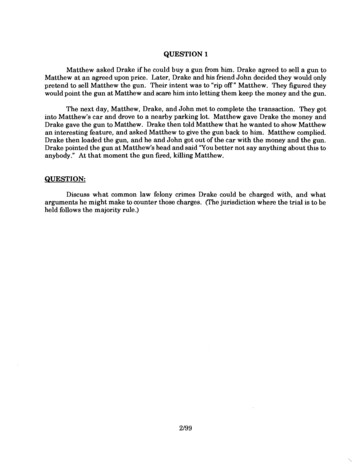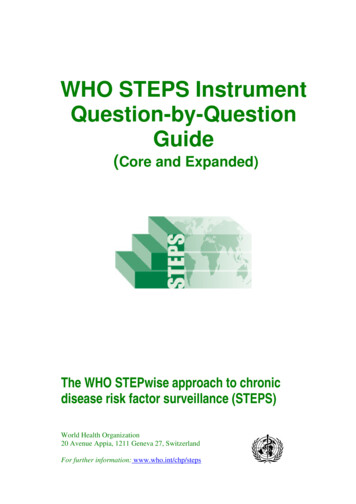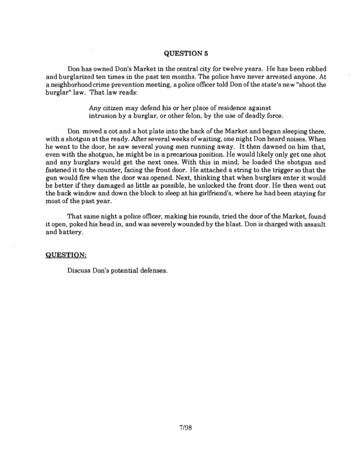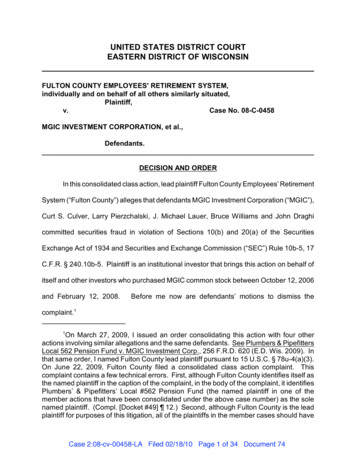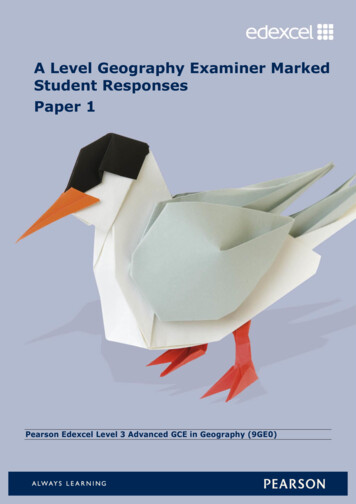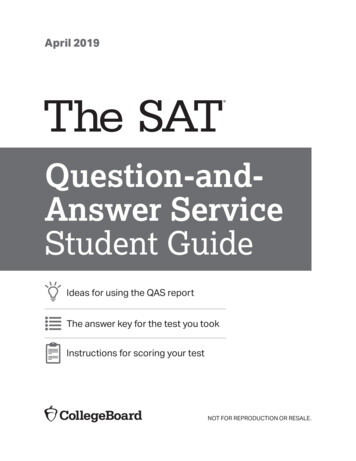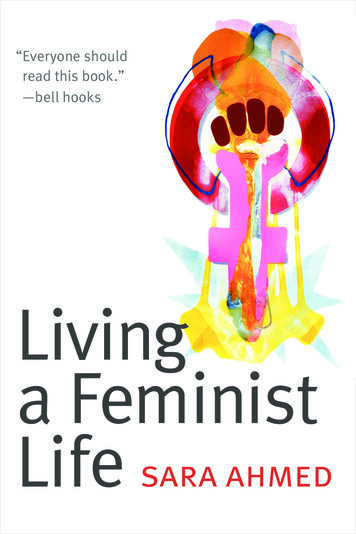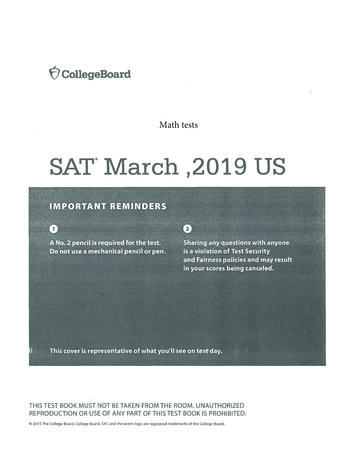
Transcription
QUESTION 1Bob Smith and Frank Smith, who are brothers, pooled their money and bought a red1972 Mustang. They titled the car under the name "Frank Smith Classic American Cars,"and spent long hours restoring it. The brothers found that many people loved the Mustangand often asked to borrow it for special occasions. Bob and Frank decided they could takeadvantage of this and decided to lease the Mustang. Leasing the Mustang became such alucrative enterprise that Bob and Frank borrowed money from a bank and bought andrestored a second car, a Corvette, for the same purpose. They titled the Corvette under thename "Bob Smith Classic American Cars."Because things were going so well, Bob and Frank agreed to operate their businesstogether for the next five years. They called the business "Classic American Cars." Theyalso agreed that they would pay for all costs associated with the operation of the businessand divide what was left equally. Three months after they made this agreement, Bob waskilled in a traffic accident while driving the Corvette. The Corvette was completelydestroyed in the accident.Frank made a claim with the business's insurance company for the value of theCorvette. Shortly thereafter, a check for the loss of the car was sent to Frank. Bob's widow,however, believes that the insurance funds belong to her since the Corvette was titled inBob's name.QUESTIONS:1.Describe and define what kind of business relationship Bob and Frankestablished.2.As a result of Bob's death, what should happen to the Mustang, the debt tothe bank, the insurance proceeds, and any cash from the operation of ClassicAmerican Cars?I3.What becomes of the business as a result of Bob's death? May Frankcontinue to operate the business if Bob's widow objects?
DISCUSSION FOR QUESTION 1Bob and Frank have formed a general partnership. Accordmg to the UniformPartnership Act ("UPA"), and Revised Uniform Partnership Act ("RUPA"),a partnership is "anassociation of two or more persons to carry on as co-owners a business for profit" (UPA 6)(RUPA 202(a)). A person receiving a share of the profits is generally presumed to be apartner (RUPA 202(c)(3)).As the intention to carry on a business for profit is an essential element in forming apartnership, (UPA 6(1))(RUPA 202(a)),the brothers did not form the partnership when theMustang was first purchased for their own amusement. Only when they decided to go intobusiness leasing the car was a partnership formed.Since the Mustang purchased by the brothers before the partnership was formed theremay be some question as to whether it was to be partnership property. However, the factpattern does not indicate any intention of the part of Bob or Frank for either the Mustang orthe Corvette to be the individual property of the brother named in the title. As the Corvettewas apparently purchased with partnership funds, and so long as no contrary intent appears,titling the cars in the names of the indwidual partners with the words "Classic American Cars"on the title did not transform the cars into indwidual property (UPA 8(2))(RUPA 8203 and204). Partners are "tenants in partnership" of partnership property. Upon the death of apartner, his right in specific partnership property vests in the surviving partner, not in hissurviving heirs or next of kin (UPA 825) (RUPA 501). Therefore, Bob's widow is not entitledto keep the insurance proceeds for the Corvette. The insurance proceeds continued to bepartnership property.A &ssolution of a partnership can be caused by the death of a partner when thepartnership is for a definite term (UPA 31(4)) and (RUPA 801(a)(2). On hssolution, apartnership is not terminated, however, but continues until the winding up of partnershipaffairs is completed (UPA 30) (RUPA 802). The surviving partner has the right to wind uppartnership affairs (UPA 37) (RUPA 803). Upon &ssolution, each partner, as against h s copartners, and all persons claiming through a partner (such as Bob's widow) have the right tohave partnership property applied first to discharge partnership liabilities, with the surplusapplied to pay in cash, the net amount owing to each respective partner (UPA 38) (RUPA 807). To continue in business would have required the consent of the representative of thedeceased partner (UPA 4l(3)) (RUPA 802(b). If Bob's widow objected to Frank continuingthe business, she has the ability to have the partnershp wound up in order to obtain a cashpayment of Bob's net interest in the partnership (liquidation).Thus, the Bank debt should be paid from partnership assets and the Mustang shouldbe sold in order to convert it to cash. Then, the remaining cash of the partnershp, includmgthe insurance proceeds, should be hvided equally between Frank and Bob's widow.
Examine #Final ScoreSCORESHEET FOR QUESTION 1ASSIGN ONE POINT FOR EACH STATEMENT BELOWA partnership isla.An association of two or more persons;la.lb.To carry on as co-owners;lb.lc.A business for profit.lc.Bob and Frank formed a partnershp when theybegan to lease the car to make a profit.The death of Bob has hssolved the partnership.Upon Bob's death the process of winding up thepartnership should begin.The Mustang, should be sold in the process of windingup the partnershp.The debt to the Bank should be paid from partnership assetsbefore any distribution to partners.The insurance proceeds for the Corvette are partnership property,and do not belong to Bob's widow.The cash in the Bank remaining after liquidation of assets andpayment of debts should be hspensed equally to Frank and toBob's widow.Frank may not continue the business without the express consentof Bob's widow.
QUESTION 1Peter, Paul, and Larry decided to go into the landscaping business. The three orallydeclared that they would be partners in PPL Landscapers, sharing profits and losses equally.Peter, Paul, and Larry each contributed 2,000 to PPL to buy the equipment necessary fortheir business. Peter, Paul, and Larry then went to Sam's Stone Supply, told Sam about theirarrangement, and convinced Sam to extend credit to PPL. They also went to Sally's Soil Storeand convinced Sally to extend credit to PPL.PPL was an immediate success and before long, Peter, Paul, and Larry were eachworking on separate projects. While Peter was working a t Gus' Golf Course, Gus asked Peterif PPL would be the full-time landscape provider for the golf course. Gus indicated that thiswould require one person to be a t the golf course a t all times. Gus offered to pay PPL 75,000per year plus material expenses. Peter told Gus that he was considering quitting PPL andasked Gus if he would like to contract with him instead of PPL. Gus agreed.Peter told Paul and Larry that he was leaving PPL and asked Paul, who kept thefinancial records, to provide him with a current accounting of PPL assets. Paul refused. Peterbelieved that PPL had net assets of 9,000, so he went to Sam's Stone Supply and charged 3,000 worth of material to PPL's account. Peter decided he would keep these materials forhimself in lieu of his share of the business assets. Peter then decided that he would also obtainmaterials from Sally's Soil Store. Peter told Sally that he had quit PPL, but that PPL owedhim 2,000. He asked her to give him 2,000 worth of materials and bill PPL. She agreed.Two weeks before any of these events occurred, but after the partnership had beenformed, Paul was working on a PPL project for Hal Homeowner. While doing so, Paulinadvertently severed a gas line and caused 5,000 worth of damage to Homeowner's home.Paul never mentioned this to either Peter or Larry.QUESTION:1Discuss all issues relevant to the formation of PPL Landscapers, and identify anddiscuss all claims which can reasonably be pursued against PPL Landscapers and Peter, Paul,and Larry individually.
DISCUSSION FOR QUESTION 1As an initial matter, on its face the partnership formed by Peter, Paul and Larryappears to valid and enforceable. An oral Partnership Agreement without provision for itsduration creates a partnership a t will. Cooper v. Saunder-Hunt,,365A.2d 626. PPL is aviable partnership because a partnership requires the participation of a minimum of twopersons, as co-owners to operate a business for profit. Benton v. Albuauerque NationalBank, 701 P.2d 1025 and Revised Uniform Partnershin Act (RUPA 8202).As a member of the partnership, Peter owes a fiduciary duty to the partnership withregard to Gus' offer of employment. This fiduciary relationship imposes upon each partnerthe obligation of the utmost good faith and integrity in their dealings with one another inpartnership affairs. Laus v. Freed, 53 Cal. 2d 512. Peter's acceptance of Gus' offer on hisown behalf constitutes a breach of this fiduciary duty to the partnership and exposes Peterto liability to the partnership for that act.Peter's oral notification to Paul and Larry that he was leaving the partnership waseffective in causing a dissolution of the partnership. A partnership a t will is subject to&ssolution by either the mutual agreement of the parties or by the express intent of anyone partner. The partnership does not exist for any period of time longer than the mutualconsent allows. Yoder v. Hooner, 695 P.2d 1182.Upon the termination of the partnership (and actually a t any time during thecourse of the partnership), a partner is entitled to demand that helshe be provided with allinformation affecting the partnership. The fiduciary duty among partners is generally oneof full disclosure of all relevant information. Heskin v. Deutsch, 134 111. App. 3d 48.Therefore, Peter is entitled to be provided with an accounting of PPlls financial records andPaul wrongfully refused to provide such information.PPL is liable to Sam for the 3,000 worth of materials purchased. A partnership isliable for the contract4 it makes with third parties or contracts made on its behalf by aproperly authorized partner. Moreover, a partner can bind the partnership for contracts inthe name of the partnership if the partner is acting within the apparent scope of thepartnership business. Hallowav v. Smith, 88 S.E.2d 909. Despite the fact that PPL isliable to Sam for the 3,000 worth of materials purchased, Peter is personally liable on thatobligation. A partner who undertakes to bind his co-partners to a contract with thirdparties, but lacks the authority to do so, is personally liable on the contract. Brooke v.Glide, 39 Cal. App. 534. Peter lacked authority to bind PPL a t this point because whendissolution begins a partner may only act for purposes of winding up the partnershipaffairs.Although the partnership is liable to Sam for the purchase of materials, thepartnership is not liable to Sally. Despite the authority set forth above, where a third partyhas knowledge that the person with whom he is dealing has no authority to bind thepartnership, the third party cannot seek to hold the partnership liable under that contract.stone v. First Wvoming. Bank, 625 F.2d 332. For the reasons set forth above, Peterobviously is personally liable to Sally for the materials purchased.
DISCUSSION FOR QUESTION 1Page TwoLastly, the partnership is jointly liable for the damage caused to Hal Homeowner'sproperty. Each partner of a partnership is jointly and severally liable for the negligence ofhis co-partner. Peterson v. Brune. 273 S.W.2d 278. Because the fact pattern indicates thatthe damage to Hal Homeowner's property was the result of the negligent act of Paul,occurring in the course of PPL business, the partnership and each partner are responsiblefor such damages. The obligation will first be satisfied out of Partnership assets. If theseare insufficient, then the partners' individual assets can be used to satisfy the balance(RUPA 5807).
Please use blue or black penand write numbers clearlyA partnership may be created orally by agreement and only requires:1.la.an association of two or more persons1a.lb.to carry on as ownerslb.lc.a business for profitlc.Peter owes the partnership a fiduciary duty to disclose Gus' offerof employment, and he breached that duty.Peter's oral notification to Paul and Larry that he was leaving thepartnership was effective in causing a dissolution of the partnership.Peter was entitled to an accounting of PPL's financial records and/or Paulwrongfully refused to provide that information.PPL is liable to Sam for the 3,000 worth of materials purchased becausePeter had apparent authority.Peter is personally liable on the contract with Sam because he exceeded hisactual authority and/or if PPL pays Sam, it has a right to recover the 3,000from Peter.PPL is not liable to Sally because Sally was made aware that Peter hadleft PPL, and/or Peter can only act to wind-up PPL affairs.Peter is personally liable on the contract to Sally because he had noauthority to bind PPL.PPL and its partners are jointly and severally liable for the damage causedto Hal Homeowner.Upon dissolution all PPL debts not covered by the PPL assets become debtsof the individual partners.
QUESTION 2Andy was looking for a building suitable for an auto repair business. Bob ownedsuch a building, and together they opened an auto repair business which they namedSunrise Auto Repair. Andy provided the tools, equipment, and expertise, and Bobprovided the building. They agreed to split the revenues equally after all costs werededucted.Sunrise Auto Repair was a success. After only one year they hired Carl, anothermechanic, to help with the workload. Carl was paid 15% of the amounts charged tocustomers, but only on the work that he did. After Carl was hired, Sunrise accountedfor its revenues in the same fashion as before except that Carl's 15% was included a sone of the costs.A year later, Sunrise was ready to expand, but needed more capital to do so.David paid Sunrise 30,000 in exchange for 10% of the company's net profits for fiveyears. The revenues were thus to be divided during the next five years a s follows:gross revenues, less all costs including payment to Carl, to be split 10% to David, 45%to Andy, and 45% to Bob.None of these agreements has been reduced to writing.QUESTION:Discuss the potential partnership issues among the parties to these agreements.
DISCUSSION FOR QUESTION 2The Uniform Partnership Act (UPA) 6(1), and the Revised Uniform PartnershipAct @UPA)101(4), define a partnership as an association of two or more persons tocarry on as co-owners a business for profit. There are no formalities required to forma partnership. Although partnerships are often based on written agreements, thereis no requirement that the agreement be in writing.However, allcommercial associations are not partnerships. The UPAandRUPAexclude commercial associations created under other statutes, such as corporations.If the commercial association was not created under another statute, then the courtslook to the intent of the parties to determine whether they intended to form apartnership, i.e., to carry on as co-owners a business for profit, or whether theyintended some other form of commercial association. In determining the p arties intent,the UPA and RUPA provide that sharing of profits creates a presumption ofpartnership. However, this presumption is rebutted if the profits are paid for a nonpartnership purpose, including the repayment of a debt owed to a creditor, thepayment of wages for services performed by an employee, or the payment of rent to alandlord. UPA 7(4); RUPA 202(c)(3). Likewise, the sharing of gross profits, as opposedto net profits, does not, necessarily, give rise to the presumption of partnership. UPA7(3); RUPA 202(c)(2).Applying these principles, Sunrise Auto Repair is probably a partnership, andAndy and Bob are probably partners. Andy and Bob each contributed property to thebusiness. Andy contributed his tools and equipment, in addition t o his expertise. Bobcontributed the use of the building. In exchange, they share profits, and note, theyshare net, not gross profits.The issue with Carl is whether he is a partner or an employee. He is probablyan employee, not a partner. Carl might argue that he is a partner because he receivesa share of the profits. But, his share is a share of gross profits, not net profits. Hisshare most resembles the payment of wages for services performed by an employee.The issue with David is whether he is a partner or a creditor. He is probably acreditor, not a partner. David might argue that he is a partner because he alsoreceives a share of the profits. Unlike Carl, he actually receives a share of net profits.and therefore, he might argue that a presumption of partnership exists. But, he willonly receive his share for five years. After the &st five years, he will receive nothingelse from Sunrise Auto Repair. This arguably rebuts any presumption in his favor ofbeing a partner and leaves his share looking more like the repayment of a loan.
scoreSeatCT]Please use blue or black penand write numbers clearly1.A partnership is an association of two or more persons to carry onas co-owners a business for profit.1-2. There is no requirement that a'partnership agreement be in writing.2 .-3. Generally, sharing of profits creates a presumption of partnership.3.-4. Andy and Bob are partners.4.-4a. They share costs (losses or net profits).5. Carl is not a partner.5a. His share resembles wages for services performed, therefore he isan employee.6. David is not a partner.6a. He is a creditor who is actually being repaid for a loan.4a.5.5a.6-6a.
QUESTION 6Lorraine, Maureen, and Claudette entered into a verbal agreement to build a house on apiece of property owned by Lorraine. Maureen, who is a contractor, agreed to build thehouse. Claudette, who is a developer and realtor, agreed to arrange construction financing forthe project and to market the house. (No money changed hands among the three women.) Thewomen agreed that their respective contributions to the project were approximately equal andtherefore, when the house sold, each would receive one-third of the gross proceeds.At all times, title to the real estate was in Lorraine's name. The contracts for materialsand labor for the house were executed by Maureen. Claudette obtained the financing in hername, although she did not have title to anything.The project was begun and things went well for a while. Ultimately, the cost ofconstruction exceeded the construction loan amount, and many of the suppliers andsubcontractors were not paid.QUESTION:Discuss the relationship among Lorraine, Maureen, and Claudette and their legalobligations to the creditors. Do not discuss mechanic's or other liens, real property law, northe application of the Statute of Frauds.
DISCUSSION FOR QUESTION 6I.PartnershipA partnership is defined as an association of two or more persons to carry on, as coowners, a business for profit. Revised Uniform partnership Ac "RUPA")§ lOl(6). No specificform of agreement is necessary to constitute a partnership and it does not need to be in writing.Nor need there be subjective intent to form a partnership, only that the parties intend to run abusiness as co-owners.& RUPA §202(a). The parties' intent may be implied from their conduct.See. Yoder v. Hooper , 695 P.2d 1182, (Colo. App. 1984), Aff'd 737 P.2d 852 (Colo. 1987).Nelson v. Seaboard Sur. Co., C.A. Minn., 269 F.2d 882. (Conduct may be sufficient to form apartnership .)Intention of the parties, agreement, splitting profits, and co-ownership are indicative, butnot conclusive, of the existence of a partnership. See. In re S & D Food. Inc., 1992, 144 BR121. A person who receives a share of the profits of a business is presumed to be a partner unlessthe profits were received in payment of a debt, services, or as wages, rent, retirement or healthbenefits, interest on a loan, or sale of goodwill of a business. RUPA 5 202(c)(3). Joint ownershipof property may by itself, but does not necessarily, establish partnership. RUPA §202(c)(l).Neither does sharing of gross returns necessarily of itself establish partnership whether or not thepersons sharing them have a joint or common interest in any property from which the returns arederived. RUPA §202(c)(2), and Yoder v. Hooper , supra.In general partnerships, each of the partners is jointly and severally liable for allpartnership debts and obligations. RUPA §306(a). Partners are considered agents for each otherand may bind the partnership when they act within the scope of their authority. RUPA, §301(1);Black v. First Federal Sav. and Loan Ass'n of Fargo, North Dakota, F. A., App. 1992, 830 P.2d1103, certiorari granted, affirmed 857 P.2d 410. The partnership is bound where one partneracts within the scope of her actual or apparent authority, i.e., for apparently carrying on in theordinary course the partnership business. The partnership is not bound where the partner had noauthority to act for the partnership in the particular matter and the person with whom the partnerwas dealing knew or had received notification that the partner lacked authority. RUPA §301(1)and (2).11.Joint VenturesJoint ventures, sometimes known as "joint adventures," have been defined as anassociation of persons with intent to engage in a single business venture for joint profit; also asa special combination of two or more persons for a specific venture seeking profit jointly, butwithout an actual partnership existing. See, Buck v. G.W.L. Const. Co., D.C. Mo, 114 F.Supp.448, 449. Joint ventures are a relatively recent creation of the American court system. Buck v.G.W.L. Const. Co., sutxa; Aiken Mills v. U.S., CCASC 144 F.2d 23.There has been a divergence in the opinions of commentators concerning the category ofthe entity known as a joint venture. Some jurisdictions hold that a joint venture is governed by
DISCUSSION FOR QUESTION 6Page Twopartnership rules, whereas others may define it differently, if at all. See, State v. Laurendine, 196So. 278, 283, 239 ALA. 620. The Uniform Partnership Act states that "a partnership is anassociation of two or more persons to carry on as co-owners of a business for profit . . . but anyassociation formed under any other statute . . . is not a partnership under this act unless theassociation would have been a partnership . . . prior to the adoption of this act. " See, U.P. A.5 6. Also, comment 2 to the Revised Uniform Partnership Act 5 202 provides "relationships thatare called 'joint ventures' are partnerships if they otherwise fit the definition of a partnership. Anassociation is not classified as a partnership, however, simply because it is called a 'jointventure"'. See,RUPA 5 202(a).The authorities in various jurisdictions differ, and have historically differed, concerningclassification of joint ventures. In some states, Colorado for instance, joint ventures have beentraditionally considered to be a class of partnership. See, Yoder v. Hooper, supra. The mostuseful and reliable approach, however, is that of the RUPA, which requires that a partnershipsatisfy the specific definition in the Act to be classified as a partnership. The fact pattern indicatesthat although there may have been an "association" of the three persons, they were not operatinga business as co-owners. The fact that they had interests in the gross revenues of this project inand of itself does not establish a partnership. The property itself was never in co-ownership, andthe building was constructed and contracted for only by Maureen. Claudette specifically wasstated as not having title to anything in this transaction. Because the facts do not suggest apartnership, under RUPA the arrangement is something other than a partnership. Liabilitytherefore would be under common law, making Maureen responsible for the contracts she enteredinto.It could be argued under various common law or statutory provisions that Lorraine, as theowner of property which property has presumably been improved or enhanced by the building,might have liability under a theory of unjust enrichment. That argument could equally apply toMaureen as the contractor for the project, but Maureen is liable anyway and that theory does notadd new or different liability. In any case, Claudette does not appear to have unjust enrichmentliability.
SeatUIPlease use blue or black penand write numbers clearlyA partnership is defined as:la.an association of two or more persons;la.lb.to carry on as co-owners a business;lb.lc.for profit.lc.A partnership does not have to be evidenced by a written agreement.No requirement that the parties subjectively intend to form a partnership;their conduct may indicate a partnership.Sharing gross revenues or returns (as opposed to profits) does not of itselfestablish a partnership. Sharing of profits raises a presumption that apartnership exists.Joint or common interests in property do not necessarily indicate a partnership.partners may bind the partnership when acting in the scope of their actual orapparent authority.A joint venture is an association of persons with intent to engage in a singlebusiness venture for ioint vrofit; or as a special combination of twoor more persons for a specific venture seeking profit jointly, but withoutan actual partnership existing.Partners in general partnerships and joint ventures have joint and severalliability for all partnership or venture obligations.Because title to the property remained in Lorraine's name, it is presumedto be separate property.Maureen contracted with the contractors in her own name and thus remainsliable under contract theories.Claudette contracted for financing in her own name and thus remainspersonally liable under contract theories.Lorraine may have liability under a theory of unjust enrichment.
QUESTION 2Ann owned and operated Ann's Pet Store, which sold pets and pet supplies. Ann's washaving financial difficulty, so she approached her friends Bill and Claire for help. On March 1,Bill loaned 50,000 to Ann's Pet Store and agreed to be paid 50 % of the store's monthly profitsuntil the loan and agreed upon interest were fully repaid. Also on March 1, Claire wrote a checkfor 30,000 to Ann's Pet Store and agreed to be paid 25 % of the monthly profits in return for hercontribution.Ann used the proceeds from the checks to purchase equipment, supplies, and a deliverytruck for the store. Claire began working at the store and helping Ann with business policydecisions. Ann, Bill and Claire divided the profits from the store as they had agreed. The partieshad no written agreement.On July 1, Claire wrote a letter to her daughter, Debbie, wherein she stated that Claire wasassigning to Debbie all of her interest in Ann's Pet Store. On August 1, Ann paid profits toherself, Bill, and Claire. On September 1, Debbie made a demand on Ann to inspect the business"books" and for payment of the profits. On October 1, while driving the store's delivery truck,Ann hit and seriously injured a pedestrian named Paul. Ann's Pet Store did not have the truckinsured, nor did the business have liability insurance.QUESTIONS:Discuss the relationship among the parties, and whether:1. Debbie has a right to see the "books" and receive payment for the monthlyprofits;2. Paul may recover for his injuries against any of the parties or Ann's Pet Store.IAssume that the Uniform Partnership Act has been adopted in the jurisdiction where thisdispute would be litigated.
DISCUSSION FOR QUESTION 2What is the relationship of the parties?A partnership is defined as "an association of two or more persons to carry on as coowners of a business for profit" [R.U. P.A. 101(6)], which definition divides into four essentialparts.1.There must be a contractual "association. " This does not require a specificwritten or oral contract, and may be implied from the circumstances. Here,Ann, Bill, and Claire certainly have some sort of contractual relationship(beyond their friendship), because money has been paid into the business. Claireand Ann have been working in the business, and all three have been receivingprofits from the business.2.There must be "two or more persons" who jointly own the business (todistinguish a partnership from a sole proprietorship). Ann had been soleproprietor of the pet store, but the presence of Bill and Claire opens thepossibility that it now has become a partnership.3.A partnership is co-owned by the partners. The most important factorevidencing co-ownership according to the R.U.P.A. is the sharing of profits,which is said to be "prima facie evidence that a person is a partner in thebusiness" [RUPA, §202(c)(3)]. Ann, Bill and Claire did share in the profits ofthe Pet Store. Also, sharing of control, capital investment, labor, and lossestend to show o-ownership. Ann and Claire shared control or managementbecause Claire began to help with business policy decisions and began workingat the business. Bill, however, only loaned money to the pet store.4.There must be a "business for profit," and the pet store operation was bothintended to be for profit, and in actuality it earned a profit.Here, there is a very good argument that the involvement of Ann and Claire arepartners, while in Bill's case it is less likely that he is a partner.What rights does Debbie have to see the "books"and for payment of the profit?A person's interest in a partnership is personalty and may be assigned at any time andsuch assignment does not dissolve the partnership. (R.U.P.A. §503(a). It is not necessarythat the other partners approve of the assignment. However, an assignee of an interest hasonly the right to receive distributions that the assignor would otherwise have been entitled toreceive. The assignee is not entitled to participate in the management of the partnership, torequire information on partnership transactions, or to inspect the partnership books. R. U. P.A.sec. 503. Therefore, Debbie is entitled to receive Claire's profit, but she is not entitled to seethe company books.
DISCUSSION FOR QUESTION 2Page TwoWho is liable to Paul for his injuries?Ann is per
Frank made a claim with the business's insurance company for the value of the Corvette. Shortly thereafter, a check for the loss of the car was sent to Frank. . Bob and Frank have formed a general partnership. Accordmg to the Uniform Partnership Act ("UPA"), and Revised Uniform Partnership Act ("RUPA"), a partnership is "an . to liability .
